National Parks
Cotopaxi National Park

Located in Cotopaxi Province, 44 miles from Quito, it contains 82,514 acres. There are camping sites, footpaths and basic tourist infrastructure.
FAUNA: In the paramos and forest, condors, bluebilled pointed ducks, carunculated cracaras, Andean gulls, pigeons and hummingbirds are often sighted. In so far as mammals are concerned, rabbits, whitetailed deer, gazelles, paramo wolves, pumas, bears, foxes and weasels inhabit the area.
FLORA: A great part of the park is occupied by paramo areas, where gentians, lycopodiums, almohadillas and obtrusive valerian, loricarias and chuquiragua grow.
OTHER ATTRACTIONS: Cotopaxi is the highest active volcano in the world. Covered handsomely with permanent snowcaps on top of the crater, several nearby lakes and streams are ideal sites for observing the local avifauna.
Sangay National Park
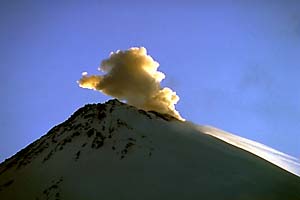
This 669,653 acer park is located in MoronaSantiago and Chimborazo provinces, 174 miles from Quito. There are camping sites and places to sleep, as well as basic tourist infrastructure.
FAUNA: Tapirs, bears, small cats, jaguars, giant otters, Chilean deer gazelles make their home in the Park, along with Andean hummingbirds, condors, Andean cockoftherock, giant hummingbird (the biggest in the world), humming ducks and king buzzards. There is a good variety of amphibians and many fish species in its rivers and lakes.
FLORA: The area supports eight plant forms; from the snow and alpine zones to humid, subtropical forest. Plant observation is very interesting and varied, especially in transition areas.
OTHER ATTRACTIONS: Since Sangay is an active volcano, large areas of it are the product of recent eruptions, and pioneer plants can be observed. Two other volcanoes are locate din the area: Altar and Tunguragua, which is also active; mountain climbing is practiced on both.
Machalilla National Park
Equipped with basic tourist infrastructure, 135,905 acres of Manabi Province have been dedicated to this park, which is 310 miles from Quito.
FAUNA: Populated by tropical, meateating primate and herbivorous species (e.g., paca, agouti, monkeys, squirrels, anteaters, sloths), marine and land birds (e.g., herons, pelicans gulls, frigate birds, small and large hawks) as well as several reptiles, land and sea turtles, snakes and lizards, and a variety of sea fish.
FLORA: Vegetation takes on three different forms: rain forest, dry forest and very dry forest. The most notable plant species are cecropia, balsa, ficus, balsamo, palm, guayacan, cactus, vines, kapok and silkcotton trees.
OTHER ATTRACTIONS: There are a great deal of archaeological sits on the coast, as well as on La Plata, Ahorcado and Salango Islands. There are small anthropological museums on Salango and Agua Blanca. the landscape is composed of beaches and sea steppes, byes and coastal forest.
Galapagos National Park and recreational Marine reserve
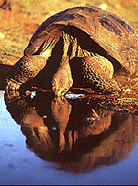
Located in the Galapagos Islands, in the Pacific Ocean 622 miles from the Ecuadorian mainland. Camping is not permitted on the islands of the archipelago as a major measure to protect the delicate ecosystem. Most visitors stay aboard the ships and yachts which are licensed to bring tourists to the islands and conduct supervised tours, others stay in small hotels on Santa Cruz and San Cristobal Islands.
FAUNA: Spectacular, with giant land tortoises, marine and land iguanas, lizards; in birds, Darwin's finches, blueand redfooted boobies, albatrosses, cormorants, frigate birds, penguins, flamingos; and in mammals seals, dolphins, whales and orcas.
FLORA: Typical of dry tropical forest vegetation, with a high endemic rate, consisting of mangroves, cactus and shrubs. Differences in flower composition is notable between one island and another. The species reflect very particular adaptations to the environment.
OTHER ATTRACTIONS: A group of very beautiful, volcanic islands with rocky, white sand beaches where one can observe the fauna unusually close. Walks on the different islands give the visitor a look at this unique, natural laboratory.
Yasuni National Park
Located in Napo Province, the western limit of Yasuni is only 190 miles from Quito. the park, which has camping sites, extends for 1,679,643 acres.
FAUNA: The fauna attraction in this park includes its fish life: piranhas, catfish and many ornamental varieties; reptiles, anacondas, boa constrictors, crocodiles, turtles and several amphibians, invertebrates and insects. In birds: king buzzards, harpies, giant tinamou, falcons, fishing eagles, royal herons, macaws and parrots; and in mammals: dolphins, manatees, tapirs, boars monkeys and giant armadillos.
FLORA: There are many types of vegetation, e.g., riparian, flooded forest or varzea, as well as firm ground forest, where relevant plant species vary over the hills and plateaus: balsa, crecopia, morete, palms, chonta palm, pambil, ficus, silkcotton, capirona, peanut trees, cinnamon, dragon's blood, jacaranda and many legumes.
OTHER ATTRACTIONS: This biosphere reserve is Ecuador's most bio diverse area. The Huaorani Indian tribe lives here: in the Tiputini, Yasuni, Cononaco and Nashino river basins, as well as on lagoon shores and navigable streams.
Podocarpus National Park
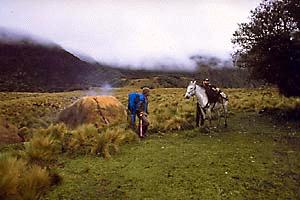
Located in Loja and Zamora provinces, Podocarpus is 435 miles from Quito and its 361,341 acres are equipped with basic infrastructure.
FAUNA: The typical sierra fauna is varied in these extensive forests. The mammal world is represented by puma, spectacled bear, fox, paramo wolf and deer, while the tiger heron, torrent duck, turkey. Andean cockoftherock, toucan, parrot, woodpecker and hummingbird represent the birds.
FLORA: The park was created to protect the large populations of two species of Angiosperms: Podocarpus rospiglios and Podocarpus oleifolius, species which have given their name to the park. The majority of the vegetation corresponds to the low, mountain rain forest and is an ideal site from which to observe orchids and wild flowers.
OTHER ATTRACTIONS: More than 100 lakes were left here by ancient glaciers. There are also many crystal clear streams and waterfall. Walks lasting several days can be made within the park to enjoy the beautiful landscapes, orchids and birds.
Cajas National Park
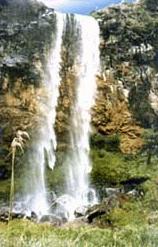
Located 324 mile from Quito, in Azuay Province, Cajas has a 71,185 acre extension; it is equipped with basic tourist infrastructure.
FAUNA: Here, one can find paramo birds such as the high altitude toucan, blackbird, water rooster, condor, hawk, pointedbill duck and bluebilled duck; paramo mammals include the wolf, gazelle, puma, bear, deer and rabbits; there are trout and native species in the lakes.
FLORA: Paramo vegetation extends over the soils formed by melting glaciers; among the most notable species are quinua, valerian, paramo (grass), wild rosemary and gentians.
OTHER ATTRACTIONS: There are 230 glacial lakes dotting the area. Geological formations and caves complement the cloudy, cold landscape.
El Boliche National Recreation Area
Located only 39 miles from Quito, in Cotopaxi Province. El Boliche's 2,448 acres are equipped with basic tourist infrastructure.
FAUNA: This recreational area was created to reintroduce white tailed deer, a program which is having good results. The fauna here is similar to that of the Cotopaxi National Park, as it is a continuation of the park.
FLORA: Paramo vegetation as well as pines introduced from North America predominate here. The scenery is varied, forming hills and valleys, streams and sites where one can rest.
OTHER ATTRACTIONS: There are camping areas and lodging facilities, footpaths and administrative center.
Cuyabeno Indian Territory and reserve for Fauna Production
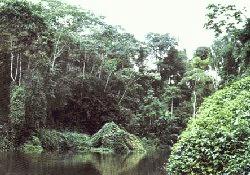
Located in Sucumbios Province, 198 miles from Quito, the Cuyabeno covers 1,619,779 acres and has basic tourist infrastructure.
FAUNA: There are abundant aquatic and land habitats, especially in so far as birds are concerned: trumpeters, macaws, turkeys, tinimous, herons, harpies, fisher eagles and king buzzards. Boars, jaguars, ocelots, monkeys, otters and manatees are mammal species found here; snakes, caymans and a variety of insects and fish can also be found.
FLORA: The tropical rain forest is heterogeneous and complex, with abundant aquatic vegetation in swamps and dry land. The most relevant of the species here are capirona, ivory nut, morete, chonta palm, chambira, wild roses and grapes and macrolobium.
OTHER ATTRACTIONS: The Cuyabeno and Aguarico river trip is a spectacular one which takes the visitor to the complex system of lagoons, swamps and flooded areas inhabited by the Siona Indian community. This region should be visited with a guide.
|